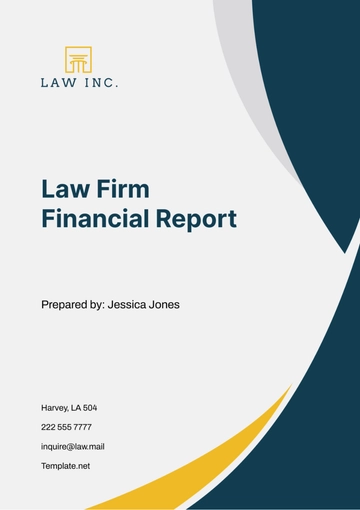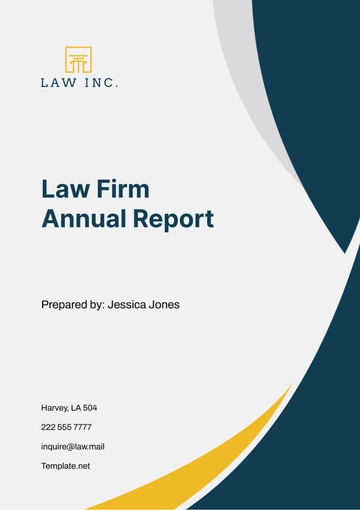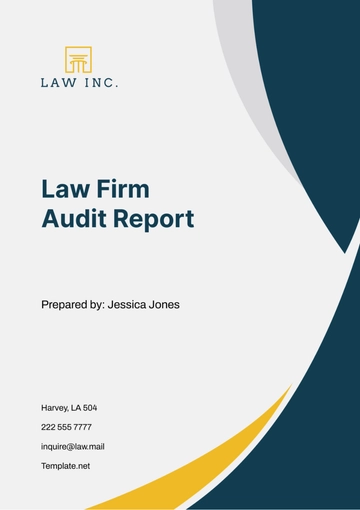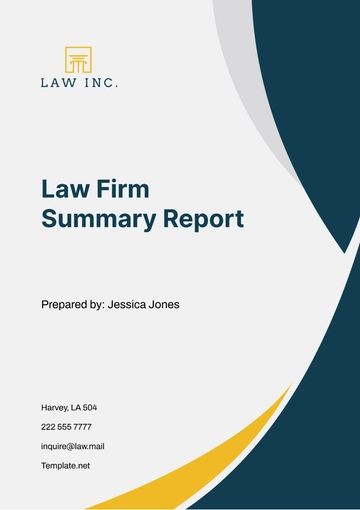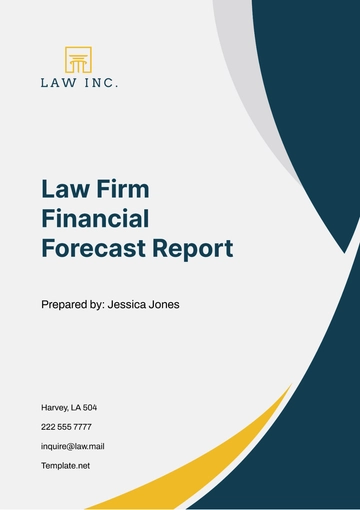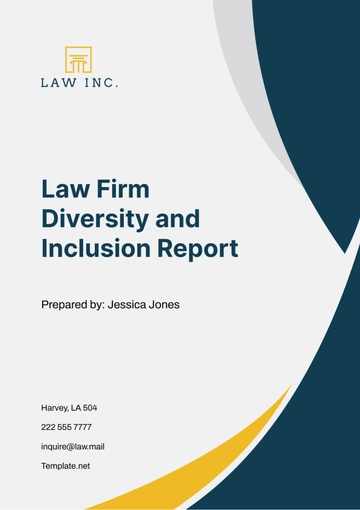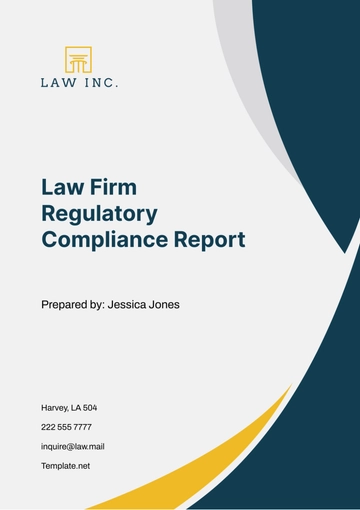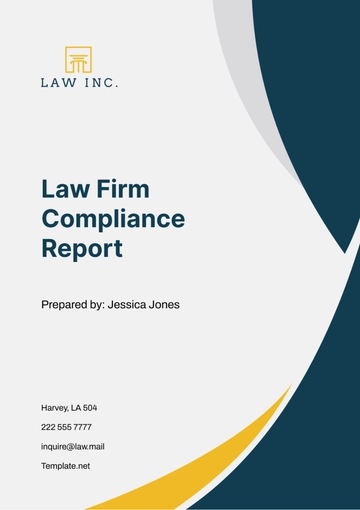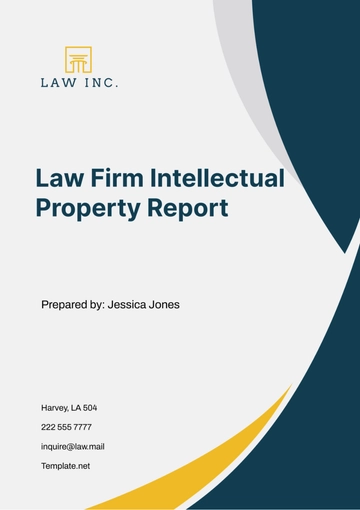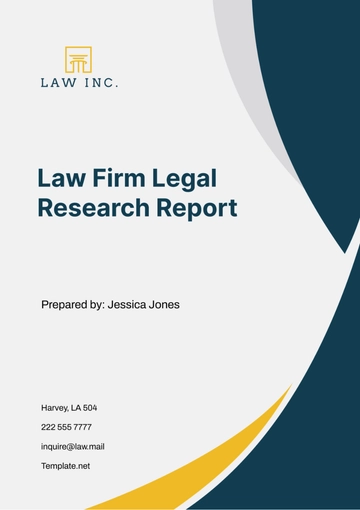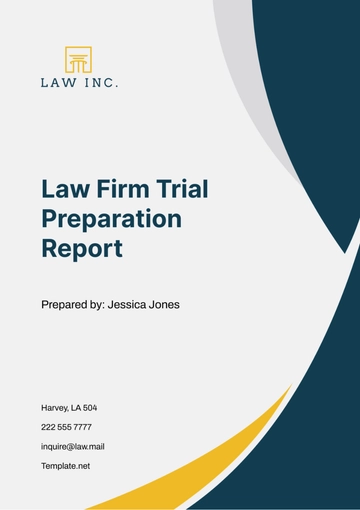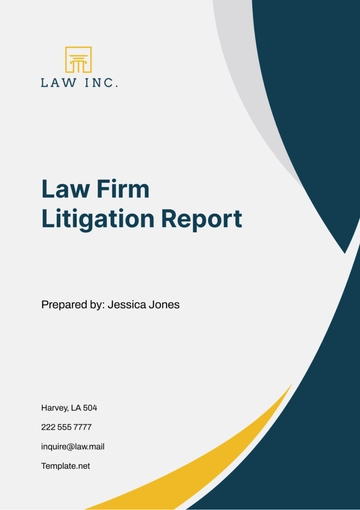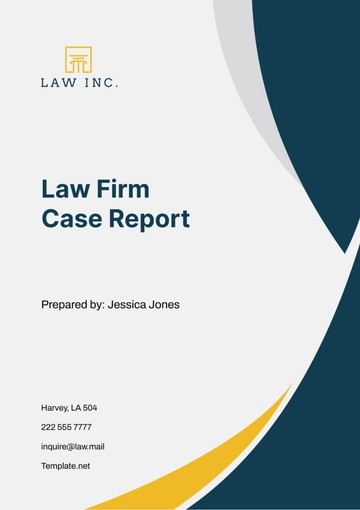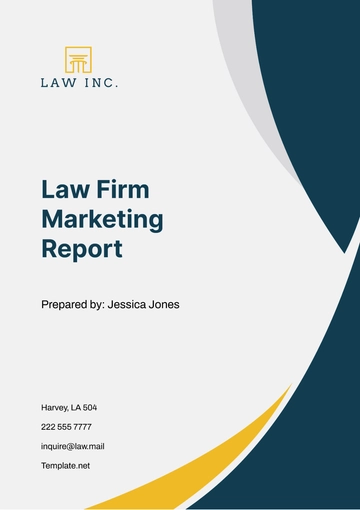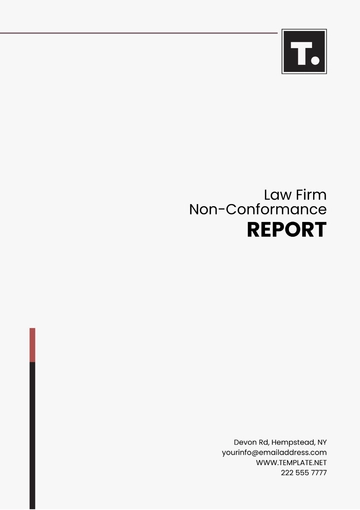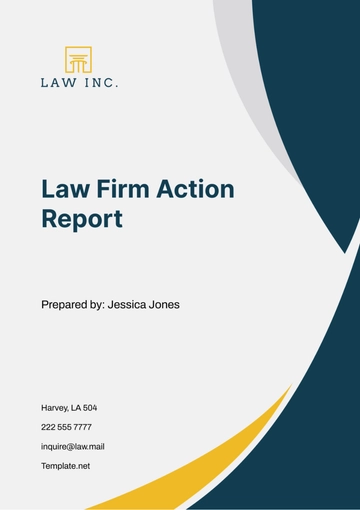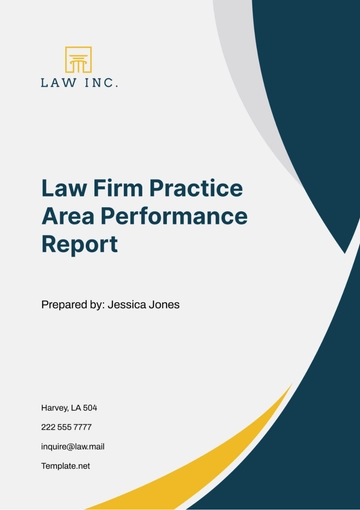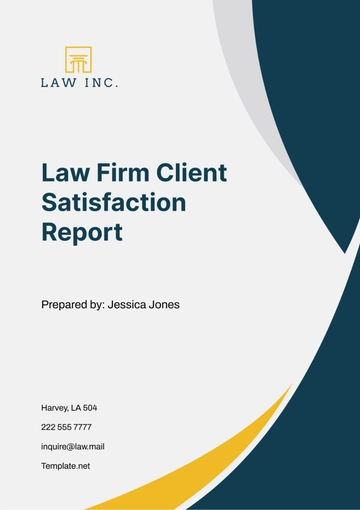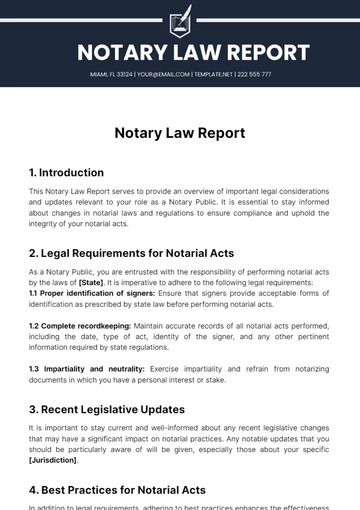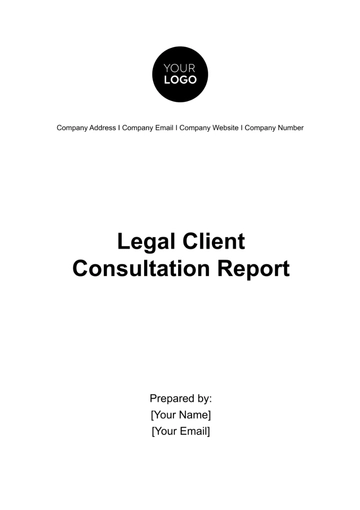Free Law Firm Litigation Report
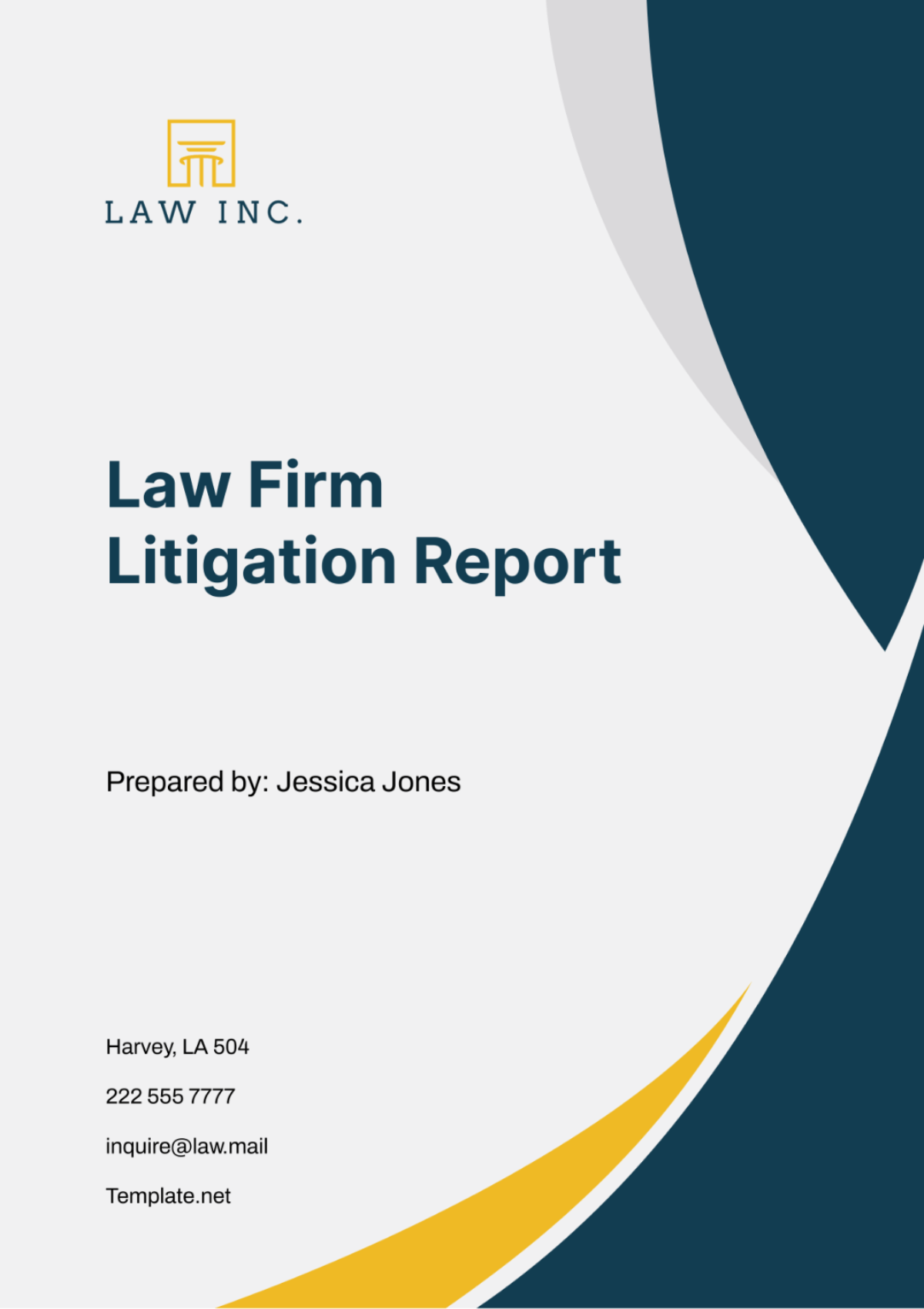
I. Executive Summary
A. Overview of Litigation
The case revolves around a breach of contract dispute between [Client Name] and [Opposing Party]. It centers on the interpretation of a commercial lease agreement regarding property usage and maintenance responsibilities.
The dispute arose when [Opposing Party] allegedly failed to uphold its obligations outlined in the lease agreement, leading to financial losses for [Client Name].
The jurisdiction lies within the state of [State], and the venue is the [Court Name].
B. Key Findings
Through comprehensive legal analysis, it has been determined that [Client Name] has strong legal grounds to pursue a claim against [Opposing Party] for breach of contract.
Case law precedent supports [Client Name]'s interpretation of the lease agreement clauses regarding property maintenance.
Based on the evidence gathered during discovery, [Client Name] has a high likelihood of prevailing in litigation.
C. Recommendations
It is recommended that [Client Name] proceed with litigation to enforce its rights under the contract and seek damages for financial losses incurred due to [Opposing Party]'s breach.
However, [Client Name] should remain open to settlement negotiations to avoid prolonged litigation and potential reputational damage.
To mitigate risks, [Client Name] should continue to document all interactions with [Opposing Party] and gather additional evidence to support its claims.
II. Introduction
A. Background Information
[Client Name] is a retail clothing store specializing in high-end fashion apparel and accessories. Headquartered in [Location], [Client Name] has established itself as a premier destination for luxury fashion enthusiasts seeking unique and trendy designs.
They entered into a commercial lease agreement with [Opposing Party] on January 1, 2055, for the premises located at [Location]. The lease agreement was for a term of five years, with an option to renew for an additional three years upon mutual agreement. The monthly rent amount was set at $10,000, payable on the first day of each month.
The lease agreement stipulates that [Client Name] has the exclusive right to use the leased premises for retail purposes, including the display and sale of clothing, accessories, and related merchandise. Additionally, [Client Name] is responsible for maintaining the interior of the leased premises in good condition, including routine cleaning, repairs, and upkeep of fixtures and furnishings.
The dispute arose when [Opposing Party], the landlord, allegedly violated several provisions of the lease agreement. Specifically, [Opposing Party] failed to fulfill its obligations regarding property maintenance and repair, despite repeated requests and notices from [Client Name]. As a result, [Client Name] suffered financial losses due to property damage, as well as operational disruptions affecting its ability to conduct business effectively.
B. Objectives
The primary objective of this litigation report is to provide [Client Name] with a comprehensive analysis of the legal issues involved in the dispute with [Opposing Party]. Additionally, the report aims to offer strategic recommendations for [Client Name] to effectively navigate the litigation process and achieve a favorable outcome.
III. Case Analysis
A. Legal Issues
Identification of Legal Claims
1.1 [Client Name] asserts the following legal claims against [Opposing Party]:
Breach of Contract: [Client Name] alleges that [Opposing Party] failed to fulfill its obligations under the lease agreement, specifically regarding property maintenance and repair.
Negligence: [Client Name] contends that [Opposing Party] acted negligently by failing to address maintenance issues promptly, resulting in financial harm to [Client Name].
1.2 Analysis of Relevant Statutes and Regulations
The lease agreement between [Client Name] and [Opposing Party] is governed by the laws of [State], specifically relevant statutes and regulations pertaining to commercial leases.
Additionally, general principles of contract law and negligence law apply to the interpretation of the lease agreement and determination of liability.
Case Strategy
2.1 Discussion of Legal Theories and Defenses
[Client Name]'s legal strategy focuses on demonstrating [Opposing Party]'s breach of contract and negligence through evidence of their failure to maintain the leased premises.
[Opposing Party] may attempt to defend against these claims by arguing potential legal defenses, such as force majeure or waiver.
2.2 Assessment of Strengths and Weaknesses
[Client Name]'s strengths lie in the clear language of the lease agreement and evidence of [Opposing Party]'s neglectful maintenance practices.
Weaknesses may include any potential weaknesses in the evidence or legal arguments that need to be addressed.
2.3 Proposed Litigation Strategy
[Client Name] intends to pursue litigation aggressively to enforce its rights under the contract and seek damages for financial losses incurred.
Additionally, [Client Name] will explore opportunities for alternative dispute resolution, such as mediation or arbitration, to expedite the resolution process.
B. Discovery
Evidence Gathering
Discovery in this case involves the exchange of relevant documents and information between parties to uncover evidence supporting their respective claims. [Client Name] has requested production of documents related to the lease agreement, property maintenance records, and communications between parties.
1.1 Description of Relevant Documents and Witnesses
[Client Name] has identified several key documents essential to proving its claims, including:
Copies of the lease agreement and any amendments
Inspection reports detailing property conditions and maintenance issues
Correspondence between [Client Name] and [Opposing Party] regarding maintenance requests and complaints
Witnesses who may provide testimony include potential witnesses, such as property managers, maintenance personnel, or third-party inspectors.
1.2 Analysis of Discovery Responses
[Client Name] has reviewed the discovery responses provided by [Opposing Party] and is in the process of evaluating the relevance and admissibility of the documents produced.
Any discrepancies or deficiencies in the discovery responses will be addressed through further investigation and potentially raised during litigation proceedings.
C. Depositions
Summary of Key Depositions
Depositions of relevant witnesses were conducted to obtain sworn testimony regarding specific issues related to the case, such as property conditions, maintenance practices, and communications between parties.
[Client Name] has summarized the key findings from these depositions to assess their impact on the case and inform its litigation strategy.
1.1 Analysis of Witness Testimony
Witness testimony obtained during depositions corroborates [Client Name]'s allegations of [Opposing Party]'s failure to maintain the leased premises adequately.
[Client Name] will leverage this testimony to support its legal claims and discredit any potential defenses raised by [Opposing Party].
V. Legal Research
A. Precedent Analysis
Review of Relevant Case Law
[Client Name]'s legal team has conducted an extensive review of case law relevant to the issues raised in the dispute with [Opposing Party].
Key cases which have established precedents regarding similar breach of contract or negligence claims in the context of commercial leases.
1.1 Comparison of Similar Cases
Analysis of similar cases demonstrates that courts have consistently upheld lease agreements' provisions regarding property maintenance and the landlord's obligations.
These cases serve as persuasive authority supporting [Client Name]'s interpretation of the lease agreement and the legal basis for its claims against [Opposing Party].
1.2 Application of Legal Principles to Current Case
[Client Name]'s legal team has applied the principles established in the relevant case law to the facts of the current case to strengthen its legal arguments.
By analogizing the facts of the present dispute to precedent cases, [Client Name] seeks to demonstrate to the court the validity of its claims and the appropriate legal remedies available.
B. Statutory Interpretation
Analysis of Applicable Statutes
The lease agreement between [Client Name] and [Opposing Party] is subject to the laws of [State], including relevant statutes governing commercial leases and landlord-tenant relationships.
[Client Name]'s legal team has thoroughly analyzed these statutes to ensure compliance with statutory requirements and to identify any statutory provisions supporting its claims.
1.1 Interpretation of Statutory Language
Interpretation of statutory language has been conducted in accordance with established principles of statutory construction, including legislative intent and judicial interpretation.
[Client Name] interprets the relevant statutes as imposing strict obligations on landlords to maintain leased premises in a safe and habitable condition, consistent with the terms of the lease agreement.
1.2 Examination of Legislative Intent
Consideration of legislative intent behind relevant statutes further supports [Client Name]'s position that [Opposing Party] is legally obligated to uphold its maintenance responsibilities under the lease agreement.
[Client Name] contends that legislative intent aims to protect tenants' rights and ensure landlords fulfill their obligations to maintain leased premises, thereby promoting a fair and equitable landlord-tenant relationship.
VI. Risk Assessment
A. Potential Liabilities
Evaluation of Potential Damages
[Client Name]'s legal team has assessed the potential damages recoverable in the event of a successful litigation outcome against [Opposing Party].
Damages may include financial losses incurred by [Client Name] as a result of [Opposing Party]'s breach of contract and negligence, such as property damage, lost revenue, and business interruption costs.
1.1 Assessment of Liability Exposure
Analysis of liability exposure considers the extent to which [Opposing Party]'s actions or omissions have contributed to [Client Name]'s damages and the likelihood of prevailing on each legal claim.
[Client Name] aims to maximize recovery of damages while minimizing potential liability risks through strategic litigation tactics and settlement negotiations.
B. Settlement Considerations
Analysis of Settlement Options
[Client Name] acknowledges the potential benefits of reaching a settlement with [Opposing Party] to resolve the dispute outside of court.
Settlement options may include negotiated monetary compensation, lease modifications, or other mutually agreeable resolutions to address [Client Name]'s grievances and avoid protracted litigation.
1.1 Cost-Benefit Analysis of Settlement versus Litigation
[Client Name]'s legal team has conducted a cost-benefit analysis to assess the advantages and disadvantages of pursuing litigation versus pursuing settlement negotiations.
Factors considered include anticipated legal expenses, potential recovery of damages, time and resources required for litigation, and the likelihood of success in court.
Based on this analysis, [Client Name] will pursue the option that offers the most favorable outcome in terms of financial costs, time efficiency, and overall risk mitigation.
VII. Conclusion
A. Summary of Findings
Recap of Key Legal Issues and Arguments
Throughout this litigation report, [Client Name] has presented compelling evidence and legal arguments supporting its claims against [Opposing Party] for breach of contract and negligence.
The analysis of relevant case law and statutory provisions demonstrates [Client Name]'s strong legal position and the validity of its interpretation of the lease agreement.
Recommendation for Next Steps
Based on the findings outlined in this report, [Client Name] is advised to continue pursuing its legal claims against [Opposing Party] through litigation or settlement negotiations.
[Client Name]'s legal team recommends specific actions, such as scheduling a settlement conference, preparing for trial, or engaging in further discovery to advance the case towards resolution.
B. Final Thoughts
Closing Remarks from Legal Team
The legal team at [Your Company Name] remains committed to advocating for [Client Name]'s interests and securing a favorable outcome in this dispute.
We are confident in the strength of [Client Name]'s legal position and stand ready to represent them effectively in any legal proceedings or negotiations moving forward.
Acknowledgment of Any Unresolved Issues
While significant progress has been made in analyzing the legal issues and developing a litigation strategy, [Client Name] acknowledges that certain aspects of the case remain unresolved.
[Client Name] will continue to work diligently with its legal counsel to address any outstanding concerns and pursue a resolution that aligns with its objectives and interests.
- 100% Customizable, free editor
- Access 1 Million+ Templates, photo’s & graphics
- Download or share as a template
- Click and replace photos, graphics, text, backgrounds
- Resize, crop, AI write & more
- Access advanced editor
Effortlessly compile litigation details with Template.net's Law Firm Litigation Report Template. This editable and customizable document streamlines the reporting process, ensuring clarity and professionalism. Crafted by legal experts, it aligns with industry standards and best practices. Editable in our Ai Editor Tool for seamless customization and integration into your firm's litigation management system.
You may also like
- Sales Report
- Daily Report
- Project Report
- Business Report
- Weekly Report
- Incident Report
- Annual Report
- Report Layout
- Report Design
- Progress Report
- Marketing Report
- Company Report
- Monthly Report
- Audit Report
- Status Report
- School Report
- Reports Hr
- Management Report
- Project Status Report
- Handover Report
- Health And Safety Report
- Restaurant Report
- Construction Report
- Research Report
- Evaluation Report
- Investigation Report
- Employee Report
- Advertising Report
- Weekly Status Report
- Project Management Report
- Finance Report
- Service Report
- Technical Report
- Meeting Report
- Quarterly Report
- Inspection Report
- Medical Report
- Test Report
- Summary Report
- Inventory Report
- Valuation Report
- Operations Report
- Payroll Report
- Training Report
- Job Report
- Case Report
- Performance Report
- Board Report
- Internal Audit Report
- Student Report
- Monthly Management Report
- Small Business Report
- Accident Report
- Call Center Report
- Activity Report
- IT and Software Report
- Internship Report
- Visit Report
- Product Report
- Book Report
- Property Report
- Recruitment Report
- University Report
- Event Report
- SEO Report
- Conference Report
- Narrative Report
- Nursing Home Report
- Preschool Report
- Call Report
- Customer Report
- Employee Incident Report
- Accomplishment Report
- Social Media Report
- Work From Home Report
- Security Report
- Damage Report
- Quality Report
- Internal Report
- Nurse Report
- Real Estate Report
- Hotel Report
- Equipment Report
- Credit Report
- Field Report
- Non Profit Report
- Maintenance Report
- News Report
- Survey Report
- Executive Report
- Law Firm Report
- Advertising Agency Report
- Interior Design Report
- Travel Agency Report
- Stock Report
- Salon Report
- Bug Report
- Workplace Report
- Action Report
- Investor Report
- Cleaning Services Report
- Consulting Report
- Freelancer Report
- Site Visit Report
- Trip Report
- Classroom Observation Report
- Vehicle Report
- Final Report
- Software Report
